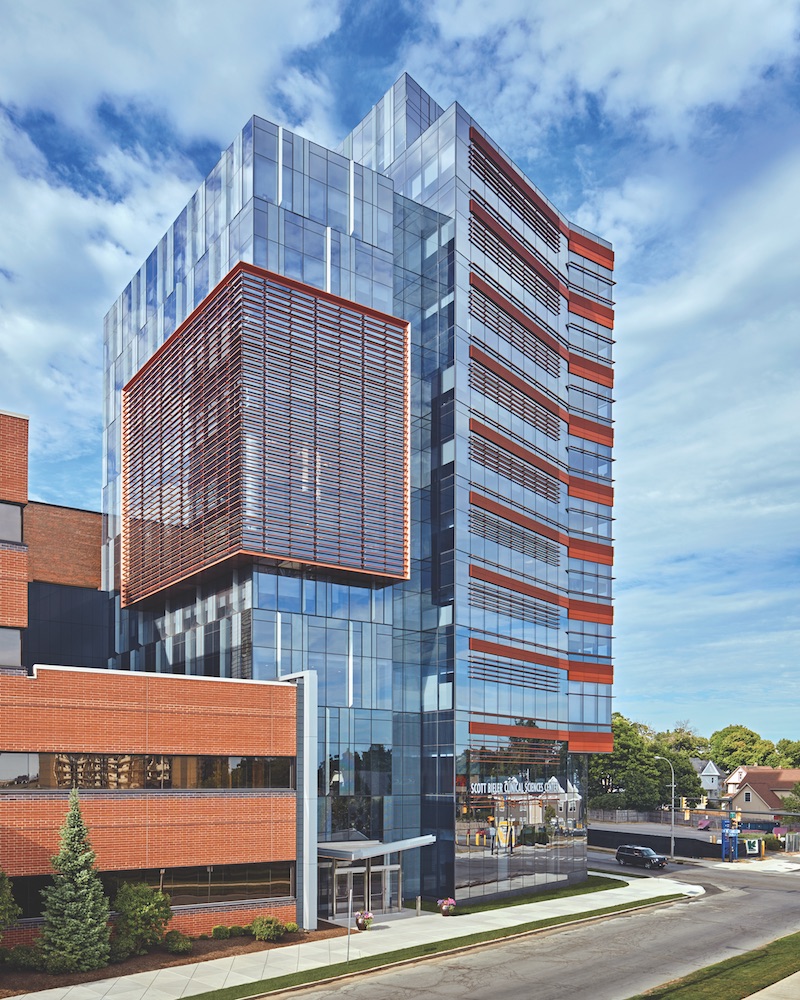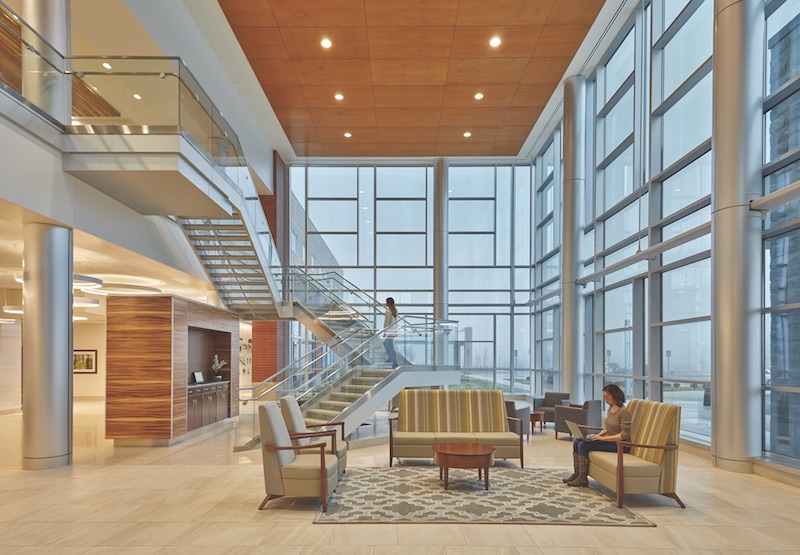No matter how things play out with the American Health Care Act, the proposed replacement for Obamacare, hospital administrators agree on one thing: “They’re going to have less money available for the care they provide,” says Collin Beers, AIA, Senior Principal, Stantec.
That has put the pinch on large-scale projects. “With uncertainty over reimbursement rates, we’re seeing fewer proposals for greenfield hospitals,” says Randy Keiser, Vice President, National Healthcare Director, Turner Construction Company. For approved projects, one popular cost-saving tactic has been to shrink rooms. “There’s been a downsizing of about 10% over the past decade,” says Keiser. “Now, many hospitals are under 2,000 sf per bed.”
Healthcare organizations continue to look for merger and acquisition opportunities to realize economies of scale, restructure their organizations, expand their geographic reach, and “rightsize” to eliminate redundant services. Stantec’s master planning service helps hospital systems with strategic planning, programming, project sequencing, and cost estimating for capital projects.
Mergers can sometimes result in improved quality of care, Beers says. “They can aggregate specialty services and create centers of excellence,” he says. A larger, more financially sound organization could have the resources to build a centralized, state-of-the-art facility in, say, cardiology or ophthalmology, with the aim of attracting top-notch specialists and fortifying the organization’s brand.
ALSO SEE: BD+C GIANTS 300 HEALTHCARE RANKINGS
Top 125 healthcare architecture firms
Top 80 healthcare engineering firms
Top 110 healthcare construction firms
Malls and strip malls have become popular locations for specialty centers and other outpatient facilities. There’s usually a lot of parking, and there may even be bus service. “In retail zones, patients have things they can do before and after their appointments,” Beers says.
Adaptive reuse of big-box stores offers unique advantages. The high ceilings of a former Kmart provide flexibility to install the extensive networks of infrastructure, Beers says. The fact that only the front elevation may need a facelift is also a plus. And with the shell already in place, the construction timetable could be faster than new construction.
But extensive and costly HVAC renovations are often necessary. Many spaces have to be partitioned. Existing systems that served big open spaces have to be rebuilt. In the end, the cost savings of turning a big-box store into an outpatient facility may not be that great. “All in all, it might be only slightly more affordable than it would be to build new,” Beers says.
 The 142,000-sf Scott Bieler Clinical Science Center serves as the new campus entryway for the 15-building, 24-acre Roswell Park Cancer Institute in downtown Buffalo, N.Y. The tower’s angular glass exterior is accented with a three-story “infusion box” with highlights of copper-mesh-embedded glass. On the Building Team: FXFOWLE (architect), Severud Associates (SE), Watts Engineering (MEP), C & S Companies (CE), and Axis Facades USA (façade consultant). © Robert Benson.
The 142,000-sf Scott Bieler Clinical Science Center serves as the new campus entryway for the 15-building, 24-acre Roswell Park Cancer Institute in downtown Buffalo, N.Y. The tower’s angular glass exterior is accented with a three-story “infusion box” with highlights of copper-mesh-embedded glass. On the Building Team: FXFOWLE (architect), Severud Associates (SE), Watts Engineering (MEP), C & S Companies (CE), and Axis Facades USA (façade consultant). © Robert Benson.
BETTER HEALING THROUGH TECHNOLOGY innovation
Some hospitals have adopted mobile tracking technology so that nurses can quickly locate equipment. “This can reduce the amount of equipment needed and the amount of spaces for their storage,” Beers says.
Technology can also come in the form of a wristband worn by patients. Instead of stewing in a noisy, stressful waiting room, patients (and their families) can relax in the cafeteria or healing garden and be notified instantly when it is their turn for a test or X-ray. This improves the patient experience and allows the facility to reduce or repurpose waiting areas.
Another technology-related trend to watch: telehealth, which offers virtual monitoring of a patient’s condition. Fifty-four hospitals have opened telehealth ICUs across the country, according to Crain’s Chicago Business. They look like air traffic control rooms, with giant monitors filled with patients’ medical data. High-definition cameras and audio equipment allow doctors and nurses to zoom in on patients and speak to them from afar.
The $54 million, 125,000-sf Mercy Virtual Care Center, in Chesterfield, Mo., enables more than 300 medical professionals to watch over patients at 38 hospitals in seven states. A Mercy official has stated that a 40% reduction in expected mortality rates in its ICUs was largely due to early interventions enabled by the Virtual Care Center’s monitoring capability.
Hospital designers are helping healthcare organizations improve patient outcomes, especially for preventable, never-should-happen occurrences like infections and slips, trips, and falls, says Keiser. Light fixtures that can kill deadly microorganisms such as MRSA and Aspergillus are gaining favor, as are antimicrobial hardware and curtains. Medical facilities are doubling down on handrails and slip-resistant flooring in patient rooms and bathrooms to reduce injuries.
In surgical units Keiser notes that advances in cardiology have made it possible for less invasive heart surgery. This makes for not only faster recovery times but also faster surgeries. As a result, some hospitals have reduced the number of ORs for cardiology and converted those spaces to catheter labs.
At a time of great uncertainty for healthcare providers, facilities designers need to be open to finding new approaches as a project progresses.
“The vast majority of healthcare projects have changes during design and construction,” Keiser says. “This seems more prevalent than it was 20 years ago.”
Related Stories
| Aug 11, 2010
Perkins+Will master plans Vedanta University teaching hospital in India
Working together with the Anil Agarwal Foundation, Perkins+Will developed the master plan for the Medical Precinct of a new teaching hospital in a remote section of Puri, Orissa, India. The hospital is part of an ambitious plan to develop this rural area into a global center of education and healthcare that would be on par with Harvard, Stanford, and Oxford.
| Aug 11, 2010
Turner Building Cost Index dips nearly 4% in second quarter 2009
Turner Construction Company announced that the second quarter 2009 Turner Building Cost Index, which measures nonresidential building construction costs in the U.S., has decreased 3.35% from the first quarter 2009 and is 8.92% lower than its peak in the second quarter of 2008. The Turner Building Cost Index number for second quarter 2009 is 837.
| Aug 11, 2010
AGC unveils comprehensive plan to revive the construction industry
The Associated General Contractors of America unveiled a new plan today designed to revive the nation’s construction industry. The plan, “Build Now for the Future: A Blueprint for Economic Growth,” is designed to reverse predictions that construction activity will continue to shrink through 2010, crippling broader economic growth.
| Aug 11, 2010
PCL Construction, HITT Contracting among nation's largest commercial building contractors, according to BD+C's Giants 300 report
A ranking of the Top 50 Commercial Contractors based on Building Design+Construction's 2009 Giants 300 survey. For more Giants 300 rankings, visit http://www.BDCnetwork.com/Giants
| Aug 11, 2010
Webcor, Hunt Construction lead the way in mixed-use construction, according to BD+C's Giants 300 report
A ranking of the Top 30 Mixed-Use Contractors based on Building Design+Construction's 2009 Giants 300 survey. For more Giants 300 rankings, visit http://www.BDCnetwork.com/Giants
| Aug 11, 2010
Report: Fraud levels fall for construction industry, but companies still losing $6.4 million on average
The global construction, engineering and infrastructure industry saw a significant decline in fraud activity with companies losing an average of $6.4 million over the last three years, according to the latest edition of the Kroll Annual Global Fraud Report, released today at the Association of Corporate Counsel’s 2009 Annual Meeting in Boston. This new figure represents less than half of last year’s amount of $14.2 million.
| Aug 11, 2010
Jacobs, HDR top BD+C's ranking of the nation's 100 largest institutional building design firms
A ranking of the Top 100 Institutional Design Firms based on Building Design+Construction's 2009 Giants 300 survey. For more Giants 300 rankings, visit http://www.BDCnetwork.com/Giants
| Aug 11, 2010
Nonprofit healthcare providers turn to real estate for liquidity and to preserve capital, says Jones Lang LaSalle report
Long considered to be stable investments immune to recession, hospitals and other healthcare facilities are now feeling the effects of a cash-strapped economy as decreased charitable contributions are forcing nonprofit hospitals to pare back and seek new financing sources, according to Jones Lang LaSalle’s 2009 Healthcare Real Estate Financing Outlook.







